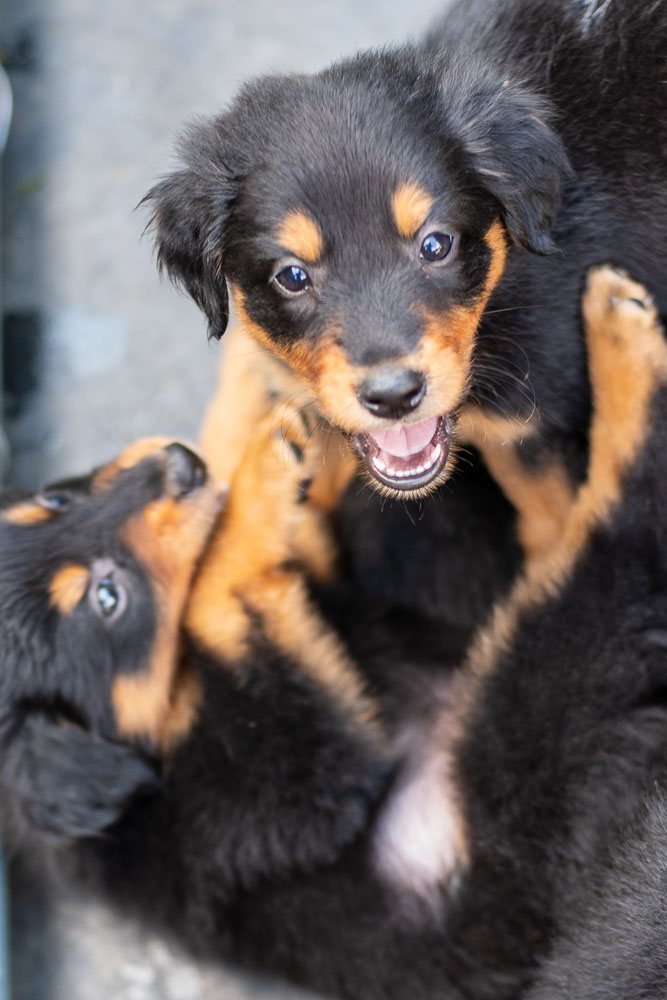In the diverse world of dog breeding, various approaches are taken towards the propagation of breeds. Two contrasting methodologies that often come to the fore are those of conservation-minded breeders and production-oriented breeders. Conservation-minded breeders and production-oriented breeders have different priorities and practices. The following list of delineations can help potential puppy buyers make informed decisions and support breeders who prioritize the health and welfare of their dogs:
- Breeding Ratio: Conservation-minded breeders tend to maintain a balanced male-to-female ratio in their breeding population, which helps to promote genetic diversity. Production-oriented breeders, on the other hand, often have more females than males in order to maximize the number of puppies produced.
- Genetic Health: Conservation breeders prioritize genetic health and diversity to strengthen the breed overall. They’ll perform genetic tests, and carefully select mating pairs to minimize the risk of hereditary diseases. Production-oriented breeders might not prioritize genetic health to the same extent, focusing more on producing large numbers of puppies.
- Litter Frequency: Conservation breeders usually limit the number of litters a female dog has in her lifetime, allowing her ample time to recover between pregnancies. This is both for the health of the female dog and the quality of the puppies. In contrast, production-oriented breeders may breed their female dogs as frequently as possible to maximize the number of puppies produced.
- Focus on Breed Standards: Conservation breeders often place a strong emphasis on maintaining and improving breed standards, including temperament, appearance, and physical traits. Production-oriented breeders might be less focused on these standards, and more on producing sellable puppies.
- Puppy Socialization and Care: Conservation breeders typically spend a lot of time socializing puppies and providing early training, which can help ensure the puppies are well-adjusted and ready for their new homes. Production-oriented breeders may not invest the same amount of time and resources into these practices.
- Long-term Commitment: Conservation breeders often maintain a commitment to the puppies they produce for the dogs’ entire lives. They’ll typically offer advice and support to new owners and will often take back any dog of their breeding if the owner can no longer care for it. Production-oriented breeders may not offer the same level of lifelong support.
- Transparency and Education: Conservation breeders are usually transparent about their breeding practices and strive to educate potential puppy buyers about responsible ownership. They’re often involved in breed clubs and organizations, which promote best practices for breeding and ownership. Production-oriented breeders may not provide the same level of education or transparency.
Next Steps
As a dog adopter or breed community members, here are some potential next steps:
- Education: Learn more about the practices of conservation-minded and production-oriented breeders. Use the resources suggested below to deepen your understanding of dog breeding.
- Outreach: If you’re considering getting a puppy, reach out to several breeders and ask them about their breeding practices. Don’t hesitate to ask about their male-to-female ratio, genetic testing, and health clearances.
- Visit: If possible, visit the breeders’ facilities. Observe the condition of the dogs and puppies, and the environment in which they’re kept.
- Consult: Speak with a trusted veterinarian or experienced dog owner about your findings and thoughts. They can provide additional insights based on their professional and personal experiences.
- Decision: Make an informed decision on where to get your puppy based on your research and consultations. Remember, your choice can help promote responsible breeding practices.
- Advocacy: Share your knowledge with others. Whether it’s through social media, at local events, or in casual conversations, you can help educate others about responsible breeding practices.
In conclusion, the differences between conservation-minded and production-oriented dog breeders are significant, each with its own impact on the breed’s health, diversity, and long-term sustainability. While conservation breeders prioritize the overall health and quality of the breed, production-oriented breeders tend to focus more on quantity. These distinctions are crucial for potential puppy adopters to understand, as their choices can greatly influence the demand and hence the practices within the breeding industry. By choosing to support breeders who prioritize the welfare and genetic diversity of their dogs, adopters can play a part in promoting healthier, more ethical breeding practices.
Further Reading
- Scott, John Paul, and John L. Fuller. 1965. Genetics and the Social Behavior of the Dog. University of Chicago Press., http://esbt.us/gf
- Kustritz, Margaret V. Root. 2018. The Dog Breeder’s Guide to Successful Breeding and Health Management. Wiley-Blackwell., http://esbt.us/gg
- Coile, Caroline. 2005. Breeding for Dog Owners – Caring from Birth to Weaning. Barron’s Educational Series., http://esbt.us/gh
- England, Gary. 2013. Dog Breeding, Whelping and Puppy Care. Crowood Press., http://esbt.us/gi
- “The Institute of Canine Biology” (www.instituteofcaninebiology.org): This organization’s website has resources and articles on canine biology, health, and genetics, which can help deepen your understanding of these topics.

